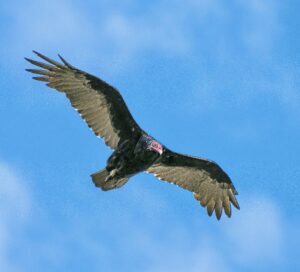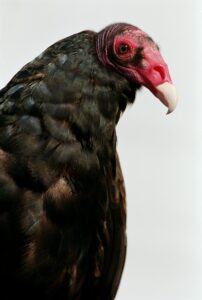Another sign fall is on its way! Turkey Vultures are on the move!
Cleon and I have been travelling. Long days of driving. We never fly because we like to drive through different areas – and we are not birds, right? But seriously…. towns, cities, farms, lakes, woods – we love to see how people live and work in different areas all over our country and Canada. When Cleon is driving and I have a break from navigating – notice, I said ‘navigating’, not ‘back-seat driving’! – I like to look for birds.
August is a good month to look for migrating raptors. And I think the easiest ones to see are Turkey Vultures.

In spring and summer, you can find Turkey Vultures in all the lower 48 states and in the very southern parts of Canada. These birds migrate and spend fall and winter in our southeastern states, and all through Central and South America. And they begin migration early – they do not wait until September.
These vultures are not like songbirds such as Gray Catbirds, Eastern Phoebes, or Baltimore Orioles who migrate in fairly straight lines. Once Turkey Vultures are aloft, they soar from thermal to thermal – rarely flapping their wings. They just seem to lazily soar in large circles. From thermal to thermal. Circle after circle.
As August days go by, Turkey Vultures come together to form loose flocks called kettles. These kettles will slowly migrate south by soaring in those lazy circles each day, and they will roost together at night.

A good place to look for these kettles is over Hawk Mountain which is close to Kempton, Pennsylvania. This is a wonderful place to watch many species of migrating birds, but from August to about mid-November, raptors come through most every day and often in big numbers. Vultures and Bald Eagles are amongst the first.
Beginning at the visitor’s center, there is a good trail to the top of the mountain with several overlooks on the way to the top. At the overlooks and at the top, there are boulders on which to sit and watch the skies. And most days, there are experts at the top from the visitor’s center who will identify all the birds seen – these people also count everything, and these numbers are kept year after year to track species and trends.
What makes Hawk Mountain special is the way the mountains are situated and how the air currents form around and between them. Many birds coming through will pass below the top of the mountain, so when you are sitting on one of those boulders at the top, you will be able to look down on a flying bird and see its back and top of head – a very different view than the underside of breast and tummy. On this trip, Cleon and I were in Pennsylvania, but not as far east as Hawk Mountain.

Another place where we have always seen kettle after kettle of Turkey Vultures in August and September is the Hoosier National Forest in southern Indiana. The towns of French Lick and West Baden are good destinations for watching Turkey Vultures. We did drive through southern Indiana and northern Kentucky on this trip, and there were a good number of Turkey Vultures. Today, we saw 25.
Turkey Vultures are wonderful birds. Remember, we owe much gratitude to all vultures. They eat carrion. They clean up. We human beings have morticians and funeral homes. Nature has vultures – and crows, eagles, beetles, and invertebrates who help. Without all of these – particularly vultures – our grasslands, meadows, and edges of woodlands, ponds, rivers, and lakes, would be filled with dead bodies of animals. The smell. The bacteria. The disease. Unimaginable!
So, the next time you pass a dead animal along the side of the road and a Turkey Vulture or two are having a meal, give them a salute and a big thank you. Afterall, they are not much different from us. We also eat meat – dead meat – carrion. We just like ours cooked and on a plate.
Hawk Mountain Sanctuary website: www.hawkmountain.org


